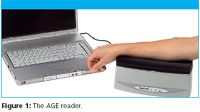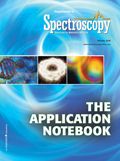The AGE Reader, a Novel Tool for Noninvasive Cardiovascular Risk Assessment
Cardiovascular diseases are among the most important causes of death in The Netherlands. It is of great importance to be able to detect these diseases at an early stage. However, current methods that use classical risk factors such as cholesterol and blood pressure do not come up to the mark.
Cardiovascular diseases are among the most important causes of death in The Netherlands. It is of great importance to be able to detect these diseases at an early stage. However, current methods that use classical risk factors such as cholesterol and blood pressure do not come up to the mark.
Recently, a Dutch, Groningen-based company DiagnOptics (see www.diagnoptics.com) has introduced the AGE Reader (see Figure 1), which is a novel method that assesses the cardiovascular risk in a simple manner. It is based on a spectrometer and UV fibre provided by Avantes Eerbeek. The AGE Reader is a first-of-its kind instrument to non-invasively measure Advanced Glycation Endproducts (AGEs) in tissue. Up until recently, this was only possible by invasive and expensive laboratory techniques that were difficult to use in a regular clinical setting.

Figure 1
AGEs are formed at an increased rate as a consequence of an excess in free oxygen radicals. This is generally referred to as oxidative stress and enhances the inflammatory process in the vascular wall that ultimately leads to cardiovascular disease. Also, AGEs have a pivotal role in the development of chronic complications of diabetes. Not only do AGEs affect the structure and function of proteins by cross-linking, in the interstitium and in cells; AGEs also stimulate cellular receptors like the receptor for AGE (RAGE), inducing cells to release cytokines. Tissue AGE levels serve as an important independent risk predictor of microvascular complications (nerve, eye and kidney damage) and of cardiovascular disease in diabetes, and predictor of mortality and cardiovascular disease in renal failure.
For the non-invasive measurement with the small, tabletop AGE Reader, patients simply place their forearm on the device to obtain a result in less than 30 seconds. The device can be operated by unskilled personnel without training. The AGE Reader shows the result as a number with clearly established reference and risk values. It makes use of the characteristic fluorescent properties of AGEs when illuminated with UV light, referred to as skin autofluorescence. The AGE-Reader consists of a small box, containing an excitation light source, emitting light with wavelengths of 300–420 nm (peak ~370 nm). Light is transmitted through a 4 cm2 large window on the upper side of the box, directly illuminating the skin. Only light reflected and emitted from the skin is measured with an integrated Avantes 2048 spectrometer in a 300–600 nm range, using 200 μm Avantes UV-fibre. Dark and white reference measurements are performed before every measurement to correct for dark current background light and to calculate reflectance, respectively. All actions are performed automatically. Each measurement is composed of the average of 50 (individual) scans, each of approximately 200 ms, depending on skin reflectance. To correct for differences in light absorption, skin AF is calculated by dividing the amount of emitted light intensity between 420 and 600 nm by the amount of excitation light intensity between 300 and 420 nm, expressed as arbitrary units.
In validation studies, it was shown that the AGE Reader is capable of accurately measuring AGEs in the skin. The amount of AGEs directly measured from skin biopsies taken from the forearm by using sophisticated laboratory techniques, were strongly related to the non-invasive measurement of the AGE Reader. Also, the AGE Reader was validated in several large-scale, clinical trials over the last few years involving over 1000 persons. Initial studies have been performed in cooperation with the University Medical Center Groningen, the Isala Clinics in Zwolle, and other major hospitals in the Netherlands. Current studies are performed by many clinical research groups worldwide. These studies validate that the AGE Reader effectively measures AGEs, and have repeatedly confirmed its value as a strong and independent risk predictor for mortality and cardiovascular events, in addition to, and on top of the risk prediction with conventional risk factors and scores. It has been shown to add substantial information to the UKPDS risk score for predicting microvascular and macrovascular (cardiovascular) complications in type 2 diabetes. In an acute setting the AGE level also provides prognostic information in patients with acute coronary syndromes.
The AGE Reader has meanwhile been incorporated in routine clinical care in several hospitals, and is now being introduced also in first-line care settings. Its application as a novel screening tool for detecting persons with increased cardiovascular risk is now being addressed.
The main function of the AGE Reader is to identify persons with a high risk for cardiovascular disease, and to do so more accurately than with the information of conventional risk factors or risk scores only. AGEs, assessed with the AGE Reader, are key players in the damage induced by glycemic and oxidative stress, novel pathogenetic pathways that strongly increase cardiovascular risk. The information from the AGE Reader assists physicians in focusing treatment on patients with the highest risk on complications. By using this method, it might perhaps be possible to start therapy at an earlier stage of disease in order to prevent complications in the future.
Avantes
Soerense Zand Noord 26 • 6961 RB EERBEEK • The Netherlands
Tel. (+31) 313 670170, Fax (+31) 313 670179

Thermo Fisher Scientists Highlight the Latest Advances in Process Monitoring with Raman Spectroscopy
April 1st 2025In this exclusive Spectroscopy interview, John Richmond and Tom Dearing of Thermo Fisher Scientific discuss the company’s Raman technology and the latest trends for process monitoring across various applications.
A Seamless Trace Elemental Analysis Prescription for Quality Pharmaceuticals
March 31st 2025Quality assurance and quality control (QA/QC) are essential in pharmaceutical manufacturing to ensure compliance with standards like United States Pharmacopoeia <232> and ICH Q3D, as well as FDA regulations. Reliable and user-friendly testing solutions help QA/QC labs deliver precise trace elemental analyses while meeting throughput demands and data security requirements.









